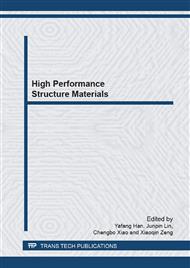p.383
p.390
p.398
p.404
p.412
p.421
p.426
p.431
p.437
Temperature Field and Cast-Rolling Force Prediction during Horizontal Twin-Roll Casting Magnesium Alloy
Abstract:
The control of process parameters in the horizontal twin-roll casting is crucial for the quality of sheet and the continuity of the process. A temperature field coupled with flow field mathematical model was established during the horizontal twin-roll casting of AZ31 magnesium alloy sheet with 1500mm in width and 8mm in thickness in this paper. The temperature field in the casting zone was solved by the software ANSYS. The effect of process factors, such as casting speed, pouring temperature and cooling intensity, on casting zone temperature of different process parameters were studied. Based on the solved temperature field, with the hot roll formula and test data of yield strength, the effect of casting speed, pouring temperature and cooling intensity on cast-rolling force in the cast-rolling zone was also dicussed. The results indicate that the casting speed has the greatest effect upon the temperature field and cast-rolling force, while the pouring temperature is the least. In addition, the value of critical cooling intensity increased with the increase of the casting speed. The quality defect called melt sheet or the leakage phenomenon appear when the cooling intensity is lower than the minimal critical cooling intensity value, and crack or rolling suspended appear if the cooling intensity is higher than the maximal critical cooling intensity value. When the casting speed are 1m/min, 2m/min and 3m/min, the minimal and maximal critical cooling intensity are 500, 1200, 2 000 W/(m2.K) and 2500, 5000, 7500 W/(m2.K) respectively.
Info:
Periodical:
Pages:
412-420
Citation:
Online since:
February 2013
Authors:
Price:
Сopyright:
© 2013 Trans Tech Publications Ltd. All Rights Reserved
Share:
Citation:


